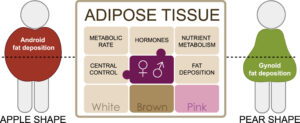Sex Differences in Fat Storage
Body fat
In general, women have more body fat than men. Studies looking at morbidity and mortality among adults suggest that the healthiest levels of body fat are considered to be 20-30% for women and 12-20% for men.
Fat distribution
The distribution of body fat is an important determination of risk to one’s health. Fat in the truncal region, including visceral fat, increases risk of metabolic disease, whereas fat in the gluteal and femoral regions appears protective.
The increased fat in the upper body and upper abdominal areas of men is an android distribution, or apple shape. In premenopausal women, the accumulation of fat in lower body (hips and thighs) is a gynoid distribution, or pear body shape.

The apple shape obesity-type is associated with increased risk for metabolic disease, whereas the pear shape is less at risk and may even be protective. For both men and women over 50 years of age, abdominal obesity appears to be the strongest predictor of insulin resistance.
Reproductive milestones
Body fat distribution is altered at key moments in a woman’s life depending on hormonal changes, specifically puberty, pregnancy, and menopause.
While more pronounced during the reproductive years, fat distribution starts showing sex-specific differences even before the onset of puberty, with girls having less waist fat and more hip fat than boys. In puberty, there is more rapid increase in fat accumulation in girls. Young women then have 10% higher fat compared to men with the same Body Mass Index (BMI), and this difference persists through adulthood.
In puberty,  the increase in body weight in boys is primarily due to an increase in lean mass whereas the increase in body weight in girls is due primarily to an increase in fat mass.
the increase in body weight in boys is primarily due to an increase in lean mass whereas the increase in body weight in girls is due primarily to an increase in fat mass.
Lactation is conceivably the most energy-demanding phase in a woman’s life, with metabolic rates being 6-8 times higher than baseline. In anticipation of this high-energy demand over a period of several months, fat is accumulated during pregnancy
At menopause, females exhibit a redistribution of their fat stores towards a central pattern, along with an increase in visceral fat, presumably due to decreased estrogen. Similarly, as men experience decreasing testosterone with aging, there is an increase in visceral fat. Estrogen protects women from the harmful effects of fat. Menopause – loss of protection
Sex hormones and fat distribution
Sex hormones determine the distribution of fat. Estrogens tell the body where to store fat, not how much fat. Estrogen drives more subcutaneous fat storage compared to androgens driving increased visceral fat. Androgens, in contrast, drive slightly more central abdominal fat – visceral fat.

Thus, the female body is designed to distribute fat in the subcutaneous regions rather than centrally. This pattern of fat distribution makes sense, in that the female body tends to develop less visceral fat in order to allow room for the uterus to expand in size with pregnancy within the abdomen – the visceral space.
As reflected by the higher body fat content throughout life, it appears that females have a higher set point for adipose tissue. In essence, the female body may be ensuring that it always has enough fat in order to produce enough leptin, which is produced by white fat. Beyond its role as the so-called “satiety” hormone, leptin appears to have many other roles and is critical for its role in fertility.
Leptin is present at higher levels throughout a female’s life. In fact, leptin levels are higher in pregnancies when the fetus is a girl. It is important for regulating pubertal development and may be responsible for the observation that girls with higher BMI begin menstruating at an earlier age. Low leptin levels are associated with infertility and loss of pregnancy.
Fat and metabolism
When adjusting for lean body mass, women have lower resting fat metabolism than men, which may contribute to increased fat storage in women.
With low to moderate intensity of exercise, it appears that women derive more energy from fats compared to men. This difference appears to be driven by estrogen, as exogenous estrogen given to men increases fat metabolism. In contrast, men tend to respond more favorably to high-intensity exercise, which can help them burn fat more efficiently.
Fat tissue is metabolically active and is considered to be an endocrine organ itself, producing leptin and numerous substances that function like hormones.
In women, increasing amounts of body fat have less impact on their insulin sensitivity compared to men. Visceral fat, more common in men, is associated with insulin resistance. These important sex differences in fat distribution explain the differences in cardiovascular risk between men and women of reproductive age.





